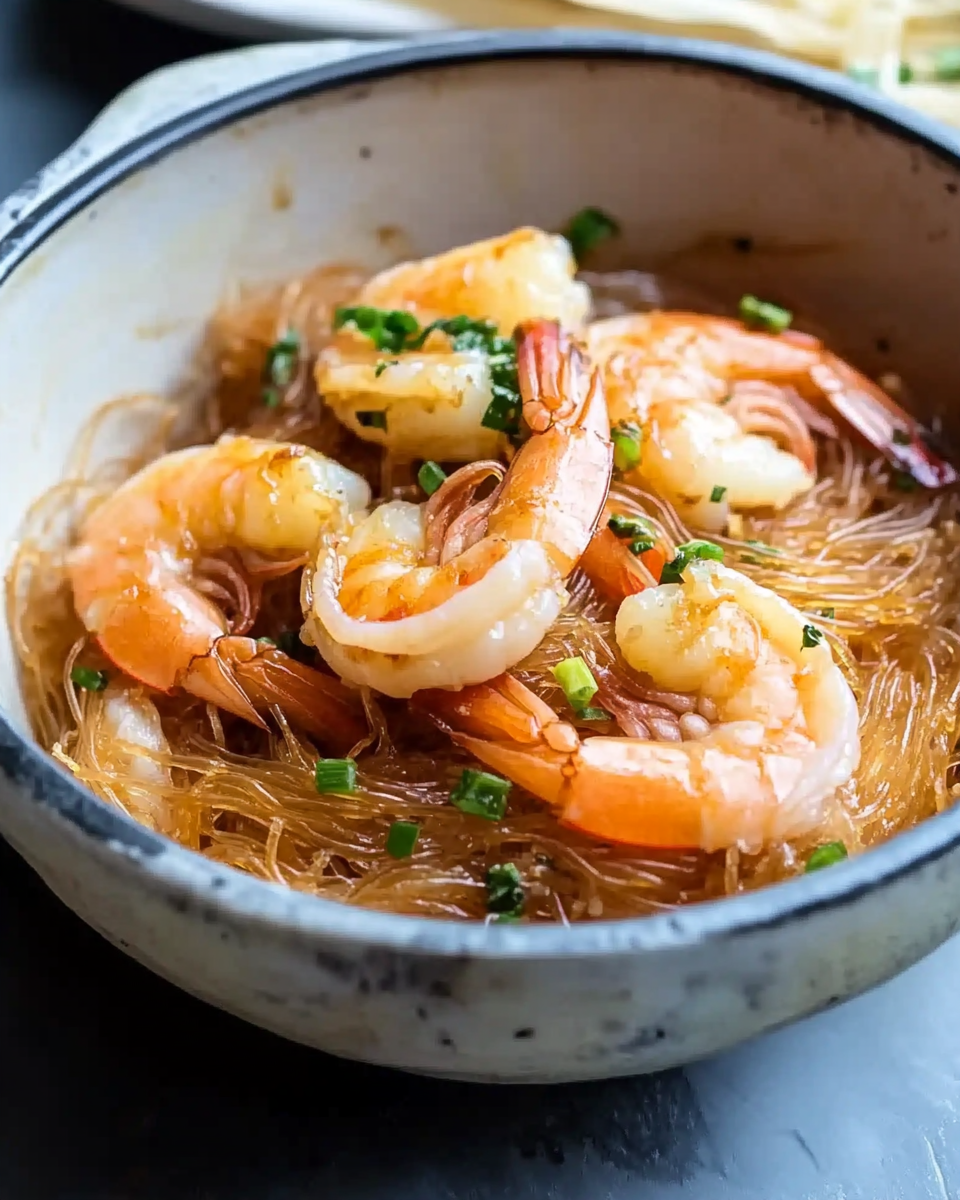Shrimp and Glass Noodles is a flavorful and light Asian-inspired dish featuring tender shrimp cooked with delicate glass noodles soaked in a savory, slightly sweet sauce. This dish is quick to prepare and perfect for a comforting dinner or lunch, combining the freshness of shrimp with the chewy texture of glass noodles and a rich umami sauce.
Full Recipe:
Ingredients
-
200g (7 oz) glass noodles (mung bean vermicelli)
-
300g (10 oz) raw shrimp, peeled and deveined
-
3 tablespoons vegetable oil
-
4 cloves garlic, minced
-
1 small onion, sliced
-
2 tablespoons soy sauce
-
1 tablespoon oyster sauce
-
1 teaspoon sugar
-
1 cup chicken or vegetable broth
-
2 stalks green onions, chopped
-
Fresh cilantro (optional), for garnish
Directions
-
Soak the glass noodles in warm water for about 10 minutes until softened. Drain and set aside.
-
Heat vegetable oil in a large skillet or wok over medium-high heat. Add garlic and onion, stir-fry until fragrant and onions soften.
-
Add shrimp to the skillet and cook until they turn pink and opaque, about 2-3 minutes.
-
Add the soy sauce, oyster sauce, sugar, and broth. Stir well to combine.
-
Add the soaked glass noodles and toss everything together, cooking for 2-3 minutes until the noodles absorb the sauce and are heated through.
-
Stir in chopped green onions.
-
Remove from heat, garnish with fresh cilantro if desired, and serve immediately.
Nutrients (per serving, estimated for 4 servings)
-
Calories: ~280 kcal
-
Protein: ~25 g
-
Fat: ~8 g
-
Carbohydrates: ~30 g
-
Fiber: ~2 g
-
Sugar: ~4 g
-
Sodium: ~900 mg
The Allure of Glass Noodles
Glass noodles, also known as mung bean vermicelli, are a staple in many Asian cuisines. They are prized for their translucent appearance and unique texture, which is soft but slightly springy when cooked. Unlike traditional wheat noodles, glass noodles are gluten-free, making this dish accessible to those with gluten sensitivities or dietary restrictions. Their mild flavor acts as a perfect canvas for the richly flavored sauce, absorbing every bit of the savory, slightly sweet liquid. This characteristic makes them a versatile ingredient that elevates simple dishes by providing an interesting texture contrast and absorbing the essence of accompanying ingredients.
Why Shrimp is the Star Protein
Shrimp is a highly popular seafood choice because of its delicate sweetness, quick cooking time, and lean protein content. It pairs exceptionally well with the subtle texture of glass noodles, providing bursts of flavor and a satisfying bite throughout the dish. Shrimp’s naturally mild taste allows it to absorb the savory notes of soy sauce and oyster sauce while adding a fresh, briny element that balances the richness of the sauce. Nutritionally, shrimp is low in calories but rich in protein, vitamins, and minerals such as iodine, making this dish both delicious and healthful.
The Flavor Profile of the Sauce
The sauce in this recipe is a beautiful interplay of umami and sweetness, primarily driven by soy sauce and oyster sauce, two pillars of Asian cooking. Soy sauce contributes salty, fermented notes that deepen the flavor, while oyster sauce adds a slightly sweet and rich complexity with a hint of oceanic essence. A touch of sugar balances these flavors by smoothing out the saltiness and adding subtle sweetness. Chicken or vegetable broth enhances the sauce by adding body and a gentle savory undertone, making the dish comforting and well-rounded. This sauce perfectly complements both the shrimp and noodles without overpowering them.
Aromatics That Elevate the Dish
Garlic and onions are essential aromatics that bring warmth and depth to this dish. When stir-fried in vegetable oil, they release fragrant oils that infuse the entire pan, creating a flavorful foundation. Garlic offers a pungent, slightly spicy note that pairs beautifully with the sweetness of the shrimp, while onions add a subtle sweetness and textural contrast. Together, these aromatics elevate the simplicity of the recipe, making every bite layered and satisfying.
The Importance of Quick Cooking
One of the highlights of this recipe is its speed and simplicity. Shrimp cooks rapidly, becoming tender and opaque within just a few minutes. This quick cooking preserves the shrimp’s juiciness and prevents it from becoming rubbery, which is crucial for maintaining the dish’s texture balance. The glass noodles, having been pre-soaked, only require brief time in the sauce to absorb flavors and heat through, making this dish a fast and efficient option without sacrificing flavor or quality. This efficiency makes it a perfect choice for those who want a wholesome meal without spending hours in the kitchen.
Nutritional Benefits
This dish is a balanced and nutritious meal option. Shrimp provides a substantial amount of lean protein essential for muscle maintenance and repair, while the glass noodles contribute a moderate amount of carbohydrates for energy. The moderate fat content comes mostly from the vegetable oil used for cooking, keeping the dish light yet satisfying. It also contains important micronutrients from shrimp, such as selenium, vitamin B12, and omega-3 fatty acids, supporting overall health. The use of fresh ingredients and a relatively low amount of added sugar keeps the dish wholesome and fitting for a health-conscious diet.
Customization and Variations
Shrimp and Glass Noodles is a versatile recipe that can easily be adapted to suit different preferences or dietary needs. You can add vegetables such as bell peppers, carrots, or snap peas to increase fiber and add crunch and color to the dish. For those who prefer a bit of heat, adding sliced chili peppers or a splash of chili oil can give the recipe a spicy kick. Using tamari instead of soy sauce makes the dish gluten-free without sacrificing flavor. Additionally, you can substitute shrimp with other proteins like chicken, tofu, or firm fish for variation, making this dish a flexible base for many meals.
Serving Suggestions
This dish pairs wonderfully with simple sides to complement its flavors and textures. Steamed jasmine or basmati rice enhances the meal with additional substance and soaks up any extra sauce. A light Asian-style salad with cucumber, carrot, and a sesame dressing provides refreshing contrast. For an added touch, garnishing with fresh cilantro not only adds a pop of color but also a fragrant, herbaceous note that balances the savory sauce. Whether served on its own or alongside other dishes, Shrimp and Glass Noodles delivers a satisfying and well-rounded dining experience.
Cultural Influences and Culinary Context
Shrimp and Glass Noodles reflects the elegance of Asian cooking, where simple ingredients are transformed through precise techniques and balanced flavors. Glass noodles are widely used across East and Southeast Asia, and the combination with shrimp is common in Chinese, Vietnamese, Thai, and Korean cuisines, each adding regional nuances to the dish. The use of oyster sauce and soy sauce highlights the importance of umami in Asian flavor profiles, which aim to create depth and harmony. This dish embodies the philosophy of creating wholesome meals that are quick to prepare yet rich in taste and texture.
Conclusion
Shrimp and Glass Noodles is a flavorful and light dish that celebrates the natural sweetness of shrimp combined with the delicate texture of glass noodles, all wrapped in a savory and slightly sweet sauce. Its quick preparation time, nutritional benefits, and balanced flavor profile make it a fantastic option for a healthy and satisfying dinner or lunch. The dish’s versatility allows for numerous adaptations to suit individual tastes and dietary needs, while its roots in Asian cuisine bring a touch of elegance and cultural richness to the table. Whether you’re looking for a comforting weeknight meal or a dish to impress guests with minimal effort, Shrimp and Glass Noodles offers a perfect blend of simplicity, flavor, and nutrition that is sure to please.






